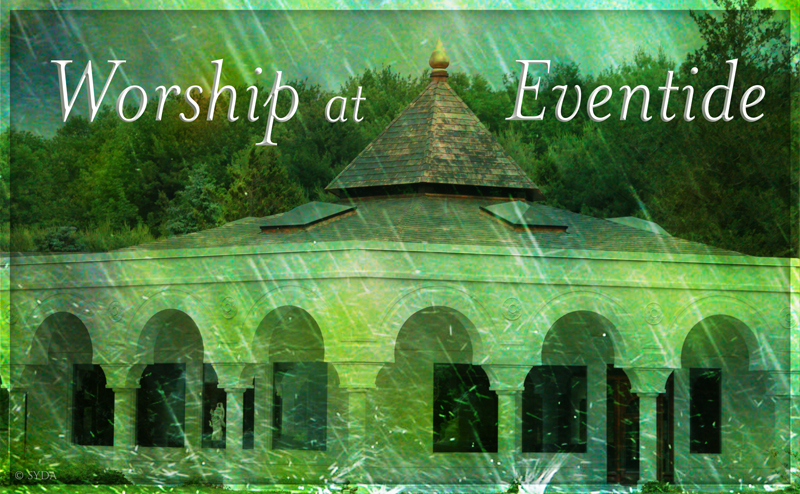Whirling Consciousness, from Sunrise to Sunset
An Account of Gurumayi’s Birthday Celebration
June 24, 2018
Shree Muktananda Ashram
Part VIII
by Participants in Gurumayi’s Birthday Celebration 2018

After a sumptuous feast for lunch—a svadisht bhandara—we made our way out of Annapurna Dining Hall, taking cover under umbrellas as we departed for our various destinations to offer seva. Yes, there was a cloudburst of elephant rain over Shree Muktananda Ashram! And yes, there are different types of rain. We’ve heard that these types of rain were described during the Month-long Course in Shree Muktananda Ashram in the early 1990s. Each kind of rain was given a name that is associated with a particular animal. For example, there is elephant rain, which comes down in thick, steady sheets. There is peacock rain—a gentle, dancing drizzle. There is deer rain, the kind of shower that descends in light sheets, like a deer prancing—and there is the more delicate mouse rain.
Here in Shree Muktananda Ashram, thunder clapped. Lightning flashed. Big, dark clouds, laden with water, rolled across the sky. It was a torrential downpour, like the monsoon in India. We were receiving blessings in abundance. Our hearts sang the song of this day: Janmadin ki Jay Jay! Gurumayi ki Jay Jay!
As sāyaṅ-kāla approached, and with that, the time for Evening Arati in the Temple, we all began to wonder: “How will we get from Atma Nidhi to Anugraha in this rainstorm?” We didn’t have to wait long for an answer. For lo and behold, just one hour before the Arati was to begin, the rainclouds began to disperse. The blue sky emerged, and the sunlight shimmered gently upon the Ashram grounds.
There is a beautiful poem that two Siddha Yogis wrote and offered to Gurumayi in honor of her birthday this year. It expresses so precisely, and so lyrically, what we were feeling in our hearts as we made our way to the Temple:

In the blossoming flowers,
in the fragrant breeze,
in the bright rays of the sun,
in the crystalline moonbeams,
this is what resonates,
this is the message:
Hail to the Birthday!
Hail to Gurumayi!
As we arrived in the Temple, we had darshan of the radiant form of Bade Baba, dressed in his golden robes and turban. We approached Bade Baba’s paduka and offered our pranam before taking our seats.
We were meditating when suddenly we heard the sound of laughter. We opened our eyes and saw Shri Gurumayi entering the Temple! We watched, in reverence and with such joy, as Gurumayi approached the paduka before Bade Baba.
One participant later said:
Being in the presence of the Siddha Yoga Gurus—both Gurumayi and Bade Baba—made me aware of the power of worship and devotion, of receiving the Guru's grace and blessings.
After Gurumayi offered her pranam to Bade Baba, Krishna, the music conductor, signaled to the pujari to begin the Evening Arati. Taking his direction, the musicians and participants together created a beautiful symphony of sounds. There were deep and steady bass drums, ringing bells, whirling pellet drums, and resonant conches.
As these sounds rang out, three pujaris took turns waving the arati lamps to Bade Baba. It is traditional to wave a succession of lamps from small to large, each lamp lit with more flames. As the third pujari completed waving the lamp, the sounds of the drums ceased. The pujari then lit the camphor, guiding the fragrant smoke toward Bade Baba’s form.
Camphor—karpūra in Sanskrit and kapūr in Hindi—is derived from the camphor laurel, an evergreen tree found in parts of Asia. The wood and bark of this tree are distilled into the white, waxy solid that we recognize as camphor. Camphor is renowned for its medicinal qualities, and when it is burned, it helps purify the atmosphere.
In India, camphor is used in temples and homes when performing worship. Brahmins light camphor as the final offering in yajna and puja rituals, and its burning represents the movement from mortality to immortality. The camphor itself signifies mortality. The aromatic plumes left behind when the camphor is burned symbolize immortality. So when devotees guide the smoke toward the deity, they are offering that which is immortal—their love and devotion. It is customary for the devotees to then waft that fragrant smoke toward themselves as a way of receiving the deity’s blessings.
In Siddha Yoga Ashrams we sing this verse in the Morning and Evening Arati:

White as camphor, he is the incarnation of compassion, the essence of the universe, and he wears the lord of the serpents as a necklace. I bow to that Shiva who, with Parvati, always dwells in the lotus of the heart.1
The air was scented with camphor as the sound of the harmonium led us into singing the Evening Arati. Our voices joined together in heartfelt praise.
The Evening Arati has been sung in Siddha Yoga Ashrams since the 1960s. Baba Muktananda selected and compiled verses from various scriptural sources to compose this Arati. (You may read more about the Evening Arati here.)
At the conclusion of the arati, we all bowed to Bade Baba and took our seats. Gurumayi then requested that Krishna invite the ensemble to begin chanting the mantra Om Namah Shivaya in Bhupali raga. As you will recall, we had chanted this mantra during the garland of namasankirtana in the Celebration Satsang. So it was a double blessing to again sing the diksha mantra, the Siddha Yoga initiation mantra, with Gurumayi. We chanted for a few minutes, our minds resting in the sounds of this mantra which gives protection to all. And then we meditated, the resonance of the mantra continuing to swirl in the atmosphere.
On the Siddha Yoga path emerging gently from meditation is of great importance. Therefore, Gurumayi has established the practice of using specific sounds, such as wind chimes and gongs, to support one in transitioning from meditation with ease. At the conclusion of the meditation after the Evening Arati on Gurumayi’s Birthday, it was the tinkling sound of chimes that drew our awareness out of meditation.
Swami Ishwarananda rose to his feet to speak, as he was the master of ceremonies for the Evening Arati. As he walked toward the microphone, Gurumayi, as well as many of us, noticed the glorious sight out the window: luminous cumulonimbus clouds, full of the promise of rain. Gurumayi spoke about how we had experienced all the seasons on this day, representing many of the countries celebrating around the globe.
Gurumayi then asked us if we wanted to stay in satsang a little longer. There was no doubt. In unison we all said, “Yes!”
Gurumayi asked Omkari Lindsey, a member of the music ensemble, what Omkari had been planning to share that morning during the Birthday Celebration Satsang. Gurumayi said she could share that now. Swami ji explained to participants that before we had all re-created the schedule for Gurumayi’s Birthday, the Teachings Council had invited Omkari to share an experience in the morning’s satsang.
Omkari thanked Gurumayi and began to speak about the Golden Tales. The Golden Tales were a phenomenal gift from Gurumayi to the children and young adults in Shree Muktananda Ashram and Gurudev Siddha Peeth between 1998 and 2001. The Golden Tales were a series of theatrical performances by the children and young adults, which were directed by Denise Thomas. In these plays, the young people enacted the lives of the poet-saints and portrayed stories from the Indian epics, the Mahabharata and the Ramayana. This year, 2018, is the twentieth anniversary of the Golden Tales.
To this day, the children who participated in these plays—children who are now adults—recall in vivid detail their experience of taking part in them. They still remember and carry with them what they learned. By narrating and playing the lives of great beings, these young people tasted the nectar of seva; they learned about making and strengthening their commitment to Siddha Yoga sadhana; they understood the importance of devotion; they experienced the power of longing and love for God; and last but not least, they were instilled with a clear sense of dharma. The legacy of these plays continues to this day. Many children grow up watching recordings of the Golden Tales and listening to the bhajan, abhanga, and qavvali that Gurumayi composed for each play. From watching these plays and listening to these songs, they come to recognize the fundamental teachings of the Siddha Yoga path.
Coming back to Omkari—she shared this about participating in the Golden Tales:
Being a part of the Golden Tales offered me so many moments to learn about how to live in and contribute to the world around me.
Though we were young children and teens, we were being given the message that we were fully capable of conveying Gurumayi’s teachings, the lives of the Siddhas and the incredible examples contained within their experiences. We were entrusted with the awesome responsibility of being vessels for sharing Gurumayi’s teachings in a concrete way. Through playing the role of Saint Janabai, I gained a deeper understanding of what it meant to embody the teachings.
Janabai’s every waking moment was dedicated to seva and to finding God. As a teenager, Janabai’s story resonated with me so strongly—and it still does—inspiring me to purely give of myself.
Omkari then sang a beautiful song that Gurumayi had written for The Golden Tales: The Life of Surdas. The words of this song are:
By singing His name, I feel joy!
Not by doing austerities,
but by singing His name, I feel joy!
Not by doing japa,
but by singing His name, I feel joy!
Not by bathing in holy rivers,
but by singing His name, I feel joy!
I feel joy singing His name!
While Omkari was singing, the heavens opened once again. Rain pounded onto the interlocking copper shingles of the Temple roof, adding its own percussive and soothing melody to the Golden Tales song. It was as if the heavens themselves were performing abhisheka to the magnificent Temple in Shree Muktananda Ashram, enveloping it in streams of blessings.
After giving us this lovely taste of what the Golden Tales were all about, Omkari sat down. We felt that she had reminded us of the significance of being in the presence of a Siddha. This was satsang—immersing ourselves in the stories of saints and Siddhas. Omkari’s song ignited within us the awareness, the understanding, of just how fortunate we were to be present in satsang with Shri Gurumayi.
Sitting in Gurumayi’s and Bade Baba’s presence, we marveled at how consummately this whole day had unfolded. We had performed worship from dawn to eventide, the virtue of devotion as our fulcrum. Through our wish and through our Siddha Yoga practices, we were sharing blessings with the entire world.
As we were in this reverie, we heard the sound of air blowing through the loudspeakers; we looked up and saw that Gurumayi was breathing into her microphone.


